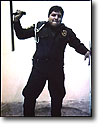Jack S. Blanton Museum of Art,
Jan 30, 2004 - Jul 18, 2004
Austin, TX, USA
Fishing in International Waters
by Annie Laurie Eddleman
For key pieces among the acquisitions, there is a booklet near the artwork that contains a statement from the artist, a statement from a party outside the art and art history community (graduate students of the University of Texas, for example), and notes from Perez Barreiro, who explains the importance of the featured acquisition, taking care to show how it relates to works on display elsewhere in the gallery and in the collection. This information augments the visitor’s experience of the exhibition, helping to clarify how the works are grouped and what the larger discourse is. These bits of information are part of the way Perez Barreiro is attempting to revise exhibition strategy -the public should understand how the curator understands the relationships of the works, yet he prevents it from becoming too academic or exclusive.
Two of the most powerful spaces in the exhibition are the installation area of Yoshua Okon’s video and the gallery space housing the works by Abel Barroso, Cildo Meireles, Leon Ferrari and Cecilia Vicuña. Okon’s video, Poli IV, is separated from the rest of the exhibition by a dividing wall. This darkened space contains a bench so that visitors can sit and watch the video of the Mexico City policeman twirling his baton like a ninja, then flexing his muscles and rubbing his groin in a pornographic martial arts routine both hilarious and disturbing. The work, the booklet lets us know, is about inflated ego and frustrated power, and the cultural cycles of struggles for power and money, law and order and survival.
There are booklets for both Ferrari’s and Barroso’s works, which are linked by their discourse on monetary circles, inaccessibility to resources in third world countries, and the possibility of endless reproduction. Barroso’s Internet de Madera (Wooden Internet), a wooden cash register-like form with a "screen" displaying a paper image of vegetables and a sign that reads www.internetdemadera.com, is a commentary on the lack of access third world countries have to "available" technologies, or the capital to make them accessible.
The wood of this piece dialogues with Cecilia Vicuña’s Precarious. Her sculptures, made from found objects -pieces of wood, plastic, etc. -or basuras as the artist calls them, refer to lack of artistic materials readily available, as well as the delicate balance between valued items and refuse. Ferrari’s map, Rua (Street) is a heliograph (of an architectural blue print), a process that creates the possibility of infinite, identical copies; thus the idea of value is called into question - what is the value of a work in the art market if infinite copies exist? This work relates well with Cildo Meireles’ Zero Dollar, another unlimited edition print. Meireles comments on the arbitrary value of money, as well as that of art, in the context of the exchange of reproducible items- art for money for the artist, money for art for the museum. The area thus creates a cyclical discourse, as Meireles’ piece ties back to what Barroso is saying about value and resource in the third world.
The overall impression of the exhibition is one of unity; the presentation of the works makes the new acquisitions seem to belong together and to balance each other. The video pieces and the three-dimensional works help to even out the two dimensional one-sided-ness of the collection. Perez Barreiro has used some good tools, such as the format of the content of the labels and booklets, and the plan of the exhibition, that enhance the meanings of the works and create a smooth and harmonious dialogue with the viewers.
|



![Cosmonauta [Cosmonaut] by Carlos Colombino](images/py_colom_01_md.jpg)
![Cosmonauta [Cosmonaut] by Carlos Colombino](images/cu_garci_03_im.jpg)



![Cosmonauta [Cosmonaut] by Carlos Colombino](images/py_colom_01_md.jpg)
![Cosmonauta [Cosmonaut] by Carlos Colombino](images/cu_garci_03_im.jpg)